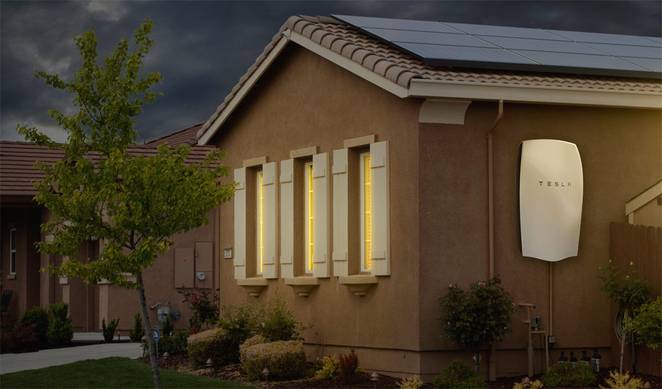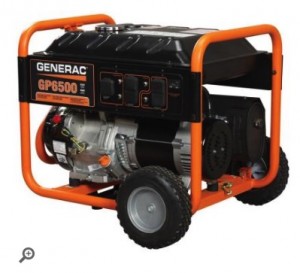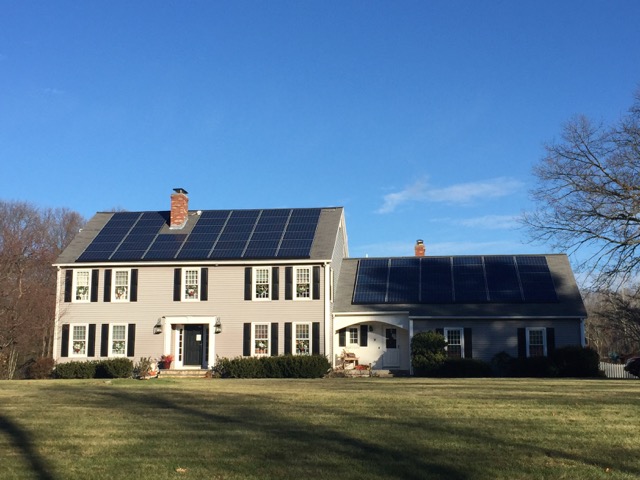Energy
A Tesla Powerwall-powered Home: Will it Pay Off?

We’ve all heard by now that the Tesla Powerwall home battery is designed to store electricity, generated from solar panels and electricity captured from utility companies during off-peak rates, and provide overall independence from the grid.
It sounds like an amazing product, and I’m sure it is, but will it pay off to own one?
Understanding the Powerwall
 The Powerwall is an energy storage unit otherwise known as a battery. It comes in two sizes today (although they can be stacked/expanded), 7kWh and 10kWh (what’s a kWh?) and costs $3,000 and $3,500, respectively. Note that the cost excludes an inverter and installation, both of which can be quite expensive to the point it can double the total out-of-pocket cost. The specs for the Powerwall come in at a whopping 220 lbs / 100 kg (unclear as to which capacity this represents) and 52.1″ x 33.9″ x 7.1″ or roughly 3.5 x 3 feet in dimension.
The Powerwall is an energy storage unit otherwise known as a battery. It comes in two sizes today (although they can be stacked/expanded), 7kWh and 10kWh (what’s a kWh?) and costs $3,000 and $3,500, respectively. Note that the cost excludes an inverter and installation, both of which can be quite expensive to the point it can double the total out-of-pocket cost. The specs for the Powerwall come in at a whopping 220 lbs / 100 kg (unclear as to which capacity this represents) and 52.1″ x 33.9″ x 7.1″ or roughly 3.5 x 3 feet in dimension.
The concept is simple, the Powerwall battery stores energy generated through your utility company when rates are the lowest (or through solar panels) and ready on tap when you need it.
Installation
Tesla notes that the cost of the Powerwall does not include the inverter or installation. An inverter alone such as the one SolarCity uses can cost around $2,000 which does not include a separate installation cost.
Installation will vary depending on the following:
- Does your residence have an existing net metering?
- Is it already wired for a generator?
- What is the distance between the photovoltaic solar panel hardware and the location to where Tesla’s Powerwall would be mounted? The shorter the distance, the less cabling to run and thus a lower installation cost.
At 200+ pounds in weight, you’ll need to ensure that there’s ample space and structural support to where the Powerwall will be installed. There also needs to be sufficient cooling space and ventilation in the mounting location.
Primary Use Cases for the Tesla Powerwall
Tesla proposes two primary use cases for the Powerwall:
- Time of Use (TOU) offset
- Backup power
Let’s explore each of these options.
Powerwall provides a Time of Use offset
In many states and countries from around the world, a Time of Use (TOU) electricity rate is available through the local utility company. The concept is simple: you pay different rates at different times of the day. During peak hours the rates are higher than they are during off hours. Many Tesla owners that live in these areas that have TOU pricing will charge their cars during the evenings when rates are typically the lowest.
Unfortunately TOU pricing is not widespread here in Massachusetts but if you’re able to take advantage of it in your area, then the Powerwall may bring some value although it would take quite awhile to recoup the initial investment.
Taking a look at TOU rates from Southern California Edison, we can see that their off-peak rate is $0.11 while peak rate comes in at $0.46 for a difference of $0.35 per kWh. The large Powerwall unit is capable of storing 10kWh. Assuming you are able to fully charge the battery during off-peak hours each and every day, you would save approximately $3.50 per day.
Since the unit itself (without install) costs $3,500, it would take approximately 1000 days or just shy of 3 years before you “broke even”. This is assuming the utility company continues to offer off-peak rates throughout the year. Add in the installation costs and you’re looking at closer to 5 years before breaking even on the Tesla Powerwall investment
Of course, there’s the argument that having a solar panel system would allow you to charge the Powerwall battery for free through sunlight, but only if you fully ignore the cost of the solar system itself.
RELATED >>> My journey to installing a SolarCity system
Owning or leasing a solar system comes with its own break-even calculations so you’ll have to factor that into the equation with the Powerwall.
Powerwall provides backup power
The other stated potential use case for the Powerwall is to use it for backup power in the event your home power is completely cut off from the grid.
Don’t expect to power your entire house with just a single 10kWh Powerwall. Tesla’s site provides some good examples of how much power common home appliances draw. For instance the Powerwall would be able to power a typical refrigerator for 2 days. This time would of course be extended if you were able to replenish the battery through a solar system.
In the case of an extended power outage (think Zombie apocalypse), you may be able to power essential home services indefinitely with a properly sized battery and solar system.
The ability to re-fill from solar is a nice benefit, but the alternative would be a noisy gasoline powered generator.
 A 6.5kW generator can be had for for as little as $800. That generator can output 32,500kWh (50% load x 10 hours according that link). That’s 3x the power at less than 25% of the cost of Tesla’s offering. The cost for that power? About $15. The generator, unlike the Powerall, is mobile and can go anywhere you go. Generators typically have very low maintenance and can be re-filled quickly regardless of weather conditions (hurricanes, snow storms, etc – all likely conditions that will cause loss of power).
A 6.5kW generator can be had for for as little as $800. That generator can output 32,500kWh (50% load x 10 hours according that link). That’s 3x the power at less than 25% of the cost of Tesla’s offering. The cost for that power? About $15. The generator, unlike the Powerall, is mobile and can go anywhere you go. Generators typically have very low maintenance and can be re-filled quickly regardless of weather conditions (hurricanes, snow storms, etc – all likely conditions that will cause loss of power).
I have a Honda 6.5kW generator. My house has its own well, septic etc. When power goes out I fire up the generator and power the things I need. I have water, hot showers, heat (oil, fired by electric which is powered by the generator), lights etc. I have run for days off that generator in some of the worst weather conditions New England can throw at me. I’d argue if you’re serious about backup power, then a generator is still the best option.
Powerwall, as a backup power option and also from a pure cost-perspective, I feel is only a good fit for those who have a solar system installed and live in an area where the climate is more stable.

Cybertruck
Tesla updates Cybertruck owners about key Powershare feature

Tesla is updating Cybertruck owners on its timeline of a massive feature that has yet to ship: Powershare with Powerwall.
Powershare is a bidirectional charging feature exclusive to Cybertruck, which allows the vehicle’s battery to act as a portable power source for homes, appliances, tools, other EVs, and more. It was announced in late 2023 as part of Tesla’s push into vehicle-to-everything energy sharing, and acting as a giant portable charger is the main advantage, as it can provide backup power during outages.
Cybertruck’s Powershare system supports both vehicle-to-load (V2L) and vehicle-to-home (V2H), making it flexible and well-rounded for a variety of applications.
However, even though the feature was promised with Cybertruck, it has yet to be shipped to vehicles. Tesla communicated with owners through email recently regarding Powershare with Powerwall, which essentially has the pickup act as an extended battery.
Powerwall discharge would be prioritized before tapping into the truck’s larger pack.
However, Tesla is still working on getting the feature out to owners, an email said:
“We’re writing to let you know that the Powershare with Powerwall feature is still in development and is now scheduled for release in mid-2026.
This new release date gives us additional time to design and test this feature, ensuring its ability to communicate and optimize energy sharing between your vehicle and many configurations and generations of Powerwall. We are also using this time to develop additional Powershare features that will help us continue to accelerate the world’s transition to sustainable energy.”
Owners have expressed some real disappointment in Tesla’s continuous delays in releasing the feature, as it was expected to be released by late 2024, but now has been pushed back several times to mid-2026, according to the email.
Foundation Series Cybertruck buyers paid extra, expecting the feature to be rolled out with their vehicle upon pickup.
Cybertruck’s Lead Engineer, Wes Morrill, even commented on the holdup:
As a Cybertruck owner who also has Powerwall, I empathize with the disappointed comments.
To their credit, the team has delivered powershare functionality to Cybertruck customers who otherwise have no backup with development of the powershare gateway. As well as those with solar…
— Wes (@wmorrill3) December 12, 2025
He said that “it turned out to be much harder than anticipated to make powershare work seamlessly with existing Powerwalls through existing wall connectors. Two grid-forming devices need to negotiate who will form and who will follow, depending on the state of charge of each, and they need to do this without a network and through multiple generations of hardware, and test and validate this process through rigorous certifications to ensure grid safety.”
It’s nice to see the transparency, but it is justified for some Cybertruck owners to feel like they’ve been bait-and-switched.
Energy
Tesla starts hiring efforts for Texas Megafactory
Tesla’s Brookshire site is expected to produce 10,000 Megapacks annually, equal to 40 gigawatt hours of energy storage.

Tesla has officially begun hiring for its new $200 million Megafactory in Brookshire, Texas, a manufacturing hub expected to employ 1,500 people by 2028. The facility, which will build Tesla’s grid-scale Megapack batteries, is part of the company’s growing energy storage footprint.
Tesla’s hiring efforts for the Texas Megafactory are hinted at by the job openings currently active on the company’s Careers website.
Tesla’s Texas Megafactory
Tesla’s Brookshire site is expected to produce 10,000 Megapacks annually, equal to 40 gigawatt hours of energy storage, similar to the Lathrop Megafactory in California. Tesla’s Careers website currently lists over 30 job openings for the site, from engineers, welders, and project managers. Each of the openings is listed for Brookshire, Texas.
The company has leased two buildings in Empire West Business Park, with over $194 million in combined property and equipment investment. Tesla’s agreement with Waller County includes a 60% property tax abatement, contingent on meeting employment benchmarks: 375 jobs by 2026, 750 by 2027, and 1,500 by 2028, as noted in a report from the Houston Business Journal. Tesla is required to employ at least 1,500 workers in the facility through the rest of the 10-year abatement period.
Tesla’s clean energy boom
City officials have stated that Tesla’s arrival marks a turning point for the Texas city, as it highlights a shift from logistics to advanced clean energy manufacturing. Ramiro Bautista from Brookshire’s economic development office, highlighted this in a comment to the Journal.
“(Tesla) has great-paying jobs. Not just that, but the advanced manufacturing (and) clean energy is coming to the area,” he said. “So it’s not just your normal logistics manufacturing. This is advanced manufacturing coming to this area, and this brings a different type of job and investment into the local economy.”
Energy
Tesla and Samsung SDI in talks over new US battery storage deal: report
The update was related by industry sources and initially reported by South Korean news outlets.

Recent reports have suggested that Tesla and Samsung SDI are in talks over a potential partnership to supply batteries for large-scale energy storage systems (ESS).
The update was related by industry sources and initially reported by South Korean news outlets.
ESS batteries to be built at Samsung’s Indiana plant
As noted in a report from Korea JoongAng Daily, the demand for energy storage systems has been growing rapidly in North America, thanks in no small part to the surge in AI investments across numerous companies. With this in mind, Tesla has reportedly approached Samsung SDI about a potential battery supply deal.
The deal is reportedly worth over 3 trillion Korean won (approximately $2.11 billion) and will span three years, according to The Korea Global Economic Daily. A battery supply deal with Samsung SDI could make sense for Tesla as the company already has a grid-scale battery, the Megapack, which is perfect for industrial use. Samsung SDI could simply supply cells for the EV maker.
Production of the batteries would reportedly take place at Samsung SDI’s joint venture factory with Stellantis in Indiana, which is currently under construction. Samsung SDI recently announced plans to use part of that plant’s EV lines to produce cells for ESS, with a targeted capacity of 30 GWh by the end of next year.
Tesla and Samsung’s partnership
At present, only a handful of manufacturers, including Korea’s LG Energy Solution, Samsung SDI, SK On, and Japan’s Panasonic, are capable of producing energy storage-scale batteries domestically in the United States. A Samsung SDI official issued a comment about the matter, stating, “Nothing has been finalized regarding cooperation with Tesla.”
The possible energy storage system deal adds another layer to Tesla’s growing collaboration with Samsung, which is already in line as a partner in the upcoming production of Tesla’s AI5 and AI6 chips. Early sample manufacturing of the AI6 is expected to begin in South Korea, with mass production slated for Samsung’s Texas-based Taylor foundry when it starts operations.
The AI6 chip will power Tesla’s next wave of high-volume projects, including the Optimus humanoid robot and the autonomous Cybercab service. Musk has called the partnership with Samsung a “real collaboration,” adding that he personally plans to “walk the line” at the Taylor facility to speed up progress.









